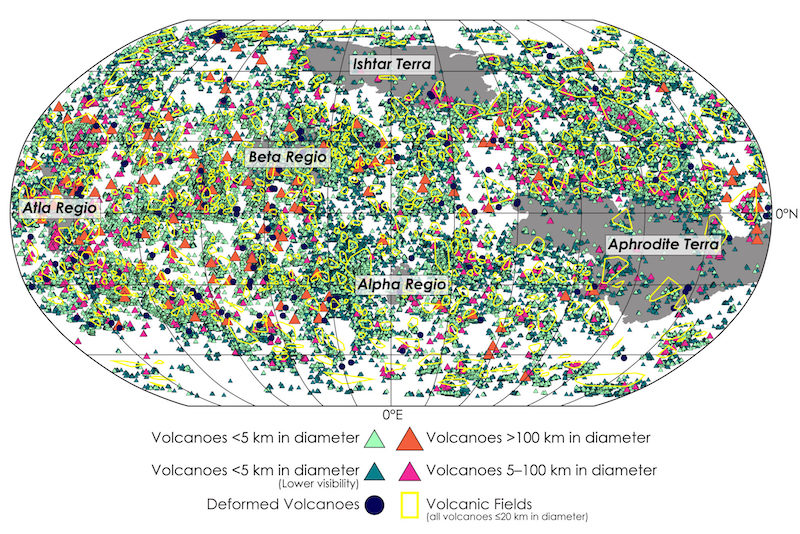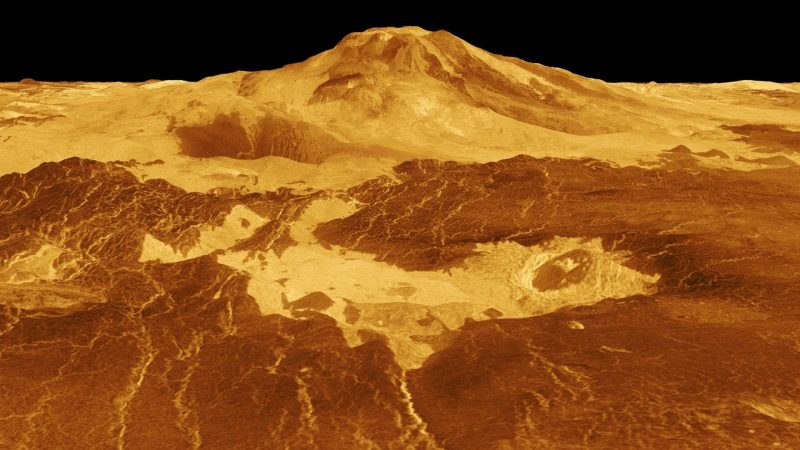
In March 2023, NASA announced the first definitive evidence for active volcanoes on Venus. And before the month ended, scientists at Washington University in St. Louis released another stunner: a new map of Venus’ volcanoes, all 85,000 of them. About 99% of them are less than three miles (five km) in diameter.
On Earth, volcanoes fall into three categories: active, dormant, or extinct. Venus is entirely covered with clouds. And we don’t know yet where the 85,000 Venus volcanoes fall in these three categories. We do know that on Earth there are about 1,350 potentially active volcanoes, according to the U.S. Geological Survey. That’s:
… aside from the continuous belts of volcanoes on the ocean floor at spreading centers like the Mid-Atlantic Ridge. About 500 of those 1,350 volcanoes have erupted in historical time.
So volcanoes on Venus – which orbits one step closer to the sun than Earth – have been a mystery. But scientists are slowly revealing Venus as a world of volcanoes, beneath its clouds.
Planetary scientists Paul Byrne and Rebecca Hahn announced the publication of their new map on March 29, 2023. The map is part of their peer-reviewed new study that they published in JGR Planets on March 24.
Last chance to get a moon phase calendar! Only a few left. On sale now.
85,000 volcanoes on Venus
The new map of Venus volcanoes is based on radar images from the early 1990s, obtained via NASA’s Magellan mission.
The researchers say that the new map is the most comprehensive ever made, showing all of Venus’ known volcanoes, both big and small. As Bern explained:
This paper provides the most comprehensive map of all volcanic edifices on Venus ever compiled. It provides researchers with an enormously valuable database for understanding volcanism on that planet. A key planetary process, but for Venus is something about which we know very little, even though it’s a world about the same size as our own.
Hahn added:
We came up with this idea of putting together a global catalog because no one’s done it at this scale before. It was tedious, but I had experience using ArcGIS software, which is what I used to build the map. That tool wasn’t available when these data first became available back in the ’90s. People back then were manually hand-drawing circles around the volcanoes, when I can just do it on my computer.
Even though Venus is completely covered by clouds, spacecraft such as NASA’s Magellan have mapped the planet using radar imagery. The researchers used radar imagery from the Magellan mission to compile the map. As it turns out, that imagery database contains an incredible 85,000 volcanoes. Bern said:
Since NASA’s Magellan mission in the 1990s, we’ve had numerous major questions about Venus’ geology, including its volcanic characteristics. But with the recent discovery of active volcanism on Venus, understanding just where volcanoes are concentrated on the planet, how many there are, how big they are, etc., becomes all the more important, especially since we’ll have new data for Venus in the coming years.
Volcanoes large and small
Notably, most of the volcanoes are fairly small, less than three miles (five km) in diameter. Hahn said:
They’re the most common volcanic feature on the planet: they represent about 99% of my dataset. We looked at their distribution using different spatial statistics to figure out whether the volcanoes are clustered around other structures on Venus, or if they’re grouped in certain areas.
Conversely, there are few volcanoes in the 12-60 mile (20-100 km) diameter range.
As the paper explains:
With the Magellan synthetic-aperture radar full-resolution radar map left- and right-look global mosaics at 75 m-per-pixel resolution, we developed a global catalog of volcanoes on Venus that contains about 85,000 edifices, about 99% of which are <5 km in diameter. We find that Venus hosts far more volcanoes than previously mapped, and that although they are distributed across virtually the entire planet, size–frequency distribution analysis reveals a relative lack of edifices in the 20–100 km diameter range, which could be related to magma availability and eruption rate.

Using the map to search for current volcanic activity
The new map will be an invaluable resource for researchers and scientists studying volcanism on Venus, as Byrne noted:
We’ve already heard from colleagues that they’ve downloaded the data and are starting to analyze them, which is exactly what we want. Other people will come up with questions we haven’t, about volcano shape, size, distribution, timing of activity in different parts of the planet, you name it. I’m excited to see what they can figure out with the new database!
This new database will enable scientists to think about where else to search for evidence of recent geological activity. We can do it either by trawling through the decades-old Magellan data (as the new Science paper did) or by analyzing future data and comparing them with Magellan data.
There is still much to learn about the history of volcanism on Venus, and how it compares to volcanism on Earth. Likewise, as the researchers also noted, there are likely still many volcanoes to be discovered under Earth’s oceans. But Venus’ terrain is completely exposed as dry land. So how many more volcanoes might scientists find on Venus?
Hundreds of thousands of volcanoes on Venus?
85,000 – which is a lot – likely isn’t the total number of volcanoes on Venus. Indeed, the researchers say there may be hundreds of thousands of volcanic features on the planet. It’s just that most of them are even smaller and harder to find in the radar images. As Hahn commented:
A volcano one kilometer in diameter in the Magellan data would be seven pixels across, which is really hard to see. But with improved resolution, we could be able to resolve those structures.
However, while they may be difficult to spot in the current radar images, new upcoming missions to Venus should be able to find more of them, as Byrne noted:
NASA and ESA (the European Space Agency) are each sending a mission to Venus in the early 2030s to take high-resolution radar images of the surface. With those images, we’ll be able to search for those smaller volcanoes we predict are there.
This is one of the most exciting discoveries we’ve made for Venus, with data that are decades old! But there is still a huge number of questions we have for Venus that we can’t answer, for which we have to get into the clouds and onto the surface. We’re just getting started.
Bottom line: Researchers at Washington University in St. Louis have compiled a new global map of the known volcanoes on Venus … All 85,000 of them.
Source: A Morphological and Spatial Analysis of Volcanoes on Venus











